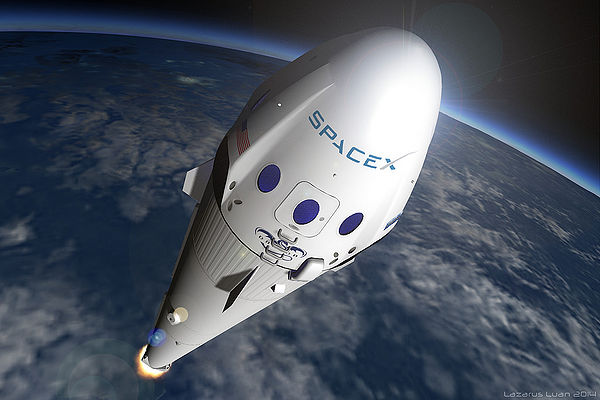Escape Velocity
Claimed by David Gamero created by Varun Rajagopal

Escape velocity is defined as the minimum velocity required for an object to escape the gravitational force of a large object. The sum of an object's kinetic energy and its Gravitational potential energy is equal to zero. The gravitational potential energy is negative due to the fact that kinetic energy is always positive. The velocity of the object will be be zero at infinite distance from the center of gravity. There is no net force on an object as it escapes and zero acceleration is perceived.
The Main Idea
The formula for escape velocity at a certain distance from a body is calculated by the formula Template:Cite book
- [math]\displaystyle{ v_e = \sqrt{\frac{2GM}{r}}, }[/math]
where G is the universal gravitational constant (G = 6.67×10−11 m3 kg−1 s−2), M is the mass of the large body to be escaped, and r the distance from the center of mass of the mass M to the object.<ref group="nb"> This equation assumes there is no atmospheric friction and is an ideal scenario with sending an object on a trajectory. In fact, the escape velocity stated here should actually be called escape speed due to the fact that the quantity to be calculated is completely independent of direction. Notice that the equation does not include the mass of the object escaping a large body as escape velocity is only dependent on gravitational force. We also assume that an object is escaping from a uniform body.
A Mathematical Model
When we model escape velocity or speed, we have to assume that an object must have a velocity an infinite distance away from a large body allowing us to find the very minimum speed to escape that large body a certain distance away. "Escape velocity" is the speed needed to go from some distance away from a large body to an infinite distance, ending at infinity with a final speed of zero. This dismisses any initial acceleration. This means that a modern spacecraft for example with propellers does not follow these assumptions.
- [math]\displaystyle{ (K + U_g)_i = (K + U_g)_f \, }[/math]
Kƒ = 0 because final velocity is zero, and Ugƒ = 0 because its final distance is expressed as infinity, therefore
- [math]\displaystyle{ \frac{1}{2}mv_e^2 + \frac{-GMm}{r} = 0 + 0 }[/math]
- [math]\displaystyle{ v_e = \sqrt{\frac{2GM}{r}} }[/math]
A Computational Model
How do we visualize or predict using this topic. Consider embedding some vpython code here Teach hands-on with GlowScript
In the following diagrams the differences highlight the energy needed to escape a gravitational field. When the total energy (kinetic plus gravitational) is equal to or greater than zero then the object can escape, this is called an unbound system (illustrated in left energy diagram). This comes from that there is at least enough kinetic energy to offset the negative potential energy, so the object ends at a distance of [math]\displaystyle{ r=\infty }[/math] with no gravitational potential energy, which means it has escaped and its initial velocity was equal to or greater than the escape velocity. On the other hand in the image on the right, kinetic energy reaches zero at a radius where potential energy is still negative, which means that the object has a velocity of zero but is still being pulled by gravity resulting in it getting dragged back in and never being able to escape. In this bound system the initial velocity was less than the escape velocity.


Examples

Escaping Jupiter's Atmosphere
The radius of Jupiter is 71500e3 m, and its mass is 1900e24 kg. What is the escape speed of an object launched straight up from just above the atmosphere of Jupiter?
System = Jupiter + object [math]\displaystyle{ \Delta E = 0\\ \\ v_i = ?\\ v_f = 0 m/s\\ r_i = 71500e3 m\\ r_f = \infty\\ m = mObject\\ M = mJupiter (1900e24 kg)\\ }[/math]
Starting from the Energy Principle:
[math]\displaystyle{ \Delta E = W + Q\\ \Delta E = (0) + (0)\\ \Delta E = 0\\ (\Delta K + \Delta U) = 0\\ \frac{1}{2}m(v_f^2-v_i^2) + (\frac{-GMm}{r_f} - \frac{-GMm}{r_i}) = 0\\ \frac{1}{2}m((0)-v_i^2) + ((0) - \frac{-GMm}{r_i}) = 0\\ \frac{-1}{2}mv_i^2 + \frac{GMm}{r_i} = 0\\ \frac{GMm}{r_i} = \frac{1}{2}mv_i^2\\ \frac{GM}{r_i} = \frac{1}{2}v_i^2\\ v_i = \sqrt{\frac{2GM}{r_i}}\\ = \sqrt{\frac{2(6.7e-11)(1900e24)}{(71500e3)}}\\ = 59672.767m/s }[/math]
Connectedness
In space, a rocket will not actually be able to travel an infinite distance once it escapes the gravitational pull of Earth, but rather must escape the gravitational pull of the Sun, the planets in our solar system, and every other larger body. The calculation of escape velocity assumes many conditions and cannot be completely applied to real life. However, if a spacecraft does not overcome the gravitational force of Earth, it will not be able to escape Earth and would likely fall back to Earth with disaster as there are many other conditions of leaving the atmosphere. The concept of escape velocity is very closely tied to the energy principle, and it is a direct application of conversion from potential to kinetic energies that is easily observable and testable. Application of this principle is most tied to aerospace and specifically spaceflight, but the underlying principle is a cross-discipline, universal concept.
External links
http://www.scientificamerican.com/article/bring-science-home-reaction-time/
https://www.youtube.com/watch?v=7w56rwAtUZU
References
"Escape Velocity | Physics." Encyclopedia Britannica Online. Encyclopedia Britannica, n.d. Web. 05 Dec. 2015. [1]
Giancoli, Douglas C. "Physics for Scientists and Engineers with Modern Physics." Google Books. Google, n.d. Web. 05 Dec. 2015. [2]
"Escape Velocity." Wikipedia. Wikimedia Foundation, n.d. Web. 05 Dec. 2015. [3]
Velocity, Escape, and ©200. ESCAPE VELOCITY EXAMPLES (n.d.): n. pag. 13 June 2003. Web. 5 Dec. 2015. [4]